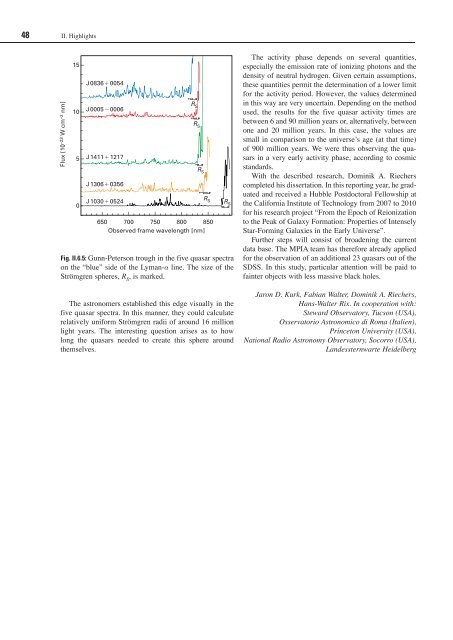Max Planck Institute for Astronomy - Annual Report 2007
Max Planck Institute for Astronomy - Annual Report 2007
Max Planck Institute for Astronomy - Annual Report 2007
Create successful ePaper yourself
Turn your PDF publications into a flip-book with our unique Google optimized e-Paper software.
48 II. Highlights<br />
Flux [10 –23 W cm –2 nm]<br />
15<br />
10<br />
5<br />
0<br />
J08360054<br />
J00050006<br />
J14111217<br />
J13060356<br />
J10300524<br />
The astronomers established this edge visually in the<br />
five quasar spectra. In this manner, they could calculate<br />
relatively uni<strong>for</strong>m Strömgren radii of around 16 million<br />
light years. The interesting question arises as to how<br />
long the quasars needed to create this sphere around<br />
themselves.<br />
R S<br />
R S<br />
R S<br />
650 700 750 800 850<br />
Observed frame wavelength [nm]<br />
R S R S<br />
Fig. II.6.5: Gunn-Peterson trough in the five quasar spectra<br />
on the “blue” side of the Lyman-a line. The size of the<br />
Strömgren spheres, R S , is marked.<br />
The activity phase depends on several quantities,<br />
especially the emission rate of ionizing photons and the<br />
density of neutral hydrogen. Given certain assumptions,<br />
these quantities permit the determination of a lower limit<br />
<strong>for</strong> the activity period. However, the values determined<br />
in this way are very uncertain. Depending on the method<br />
used, the results <strong>for</strong> the five quasar activity times are<br />
between 6 and 90 million years or, alternatively, between<br />
one and 20 million years. In this case, the values are<br />
small in comparison to the universe’s age (at that time)<br />
of 900 million years. We were thus observing the quasars<br />
in a very early activity phase, according to cosmic<br />
standards.<br />
With the described research, Dominik A. Riechers<br />
completed his dissertation. In this reporting year, he graduated<br />
and received a Hubble Postdoctoral Fellowship at<br />
the Cali<strong>for</strong>nia <strong>Institute</strong> of Technology from <strong>2007</strong> to 2010<br />
<strong>for</strong> his research project “From the Epoch of Reionization<br />
to the Peak of Galaxy Formation: Properties of Intensely<br />
Star-Forming Galaxies in the Early Universe”.<br />
Further steps will consist of broadening the current<br />
data base. The MPIA team has there<strong>for</strong>e already applied<br />
<strong>for</strong> the observation of an additional 23 quasars out of the<br />
SDSS. In this study, particular attention will be paid to<br />
fainter objects with less massive black holes.<br />
Jaron D. Kurk, Fabian Walter, Dominik A. Riechers,<br />
Hans-Walter Rix. In cooperation with:<br />
Steward Observatory, Tucson (USA),<br />
Osservatorio Astronomico di Roma (Italien),<br />
Princeton University (USA),<br />
National Radio <strong>Astronomy</strong> Observatory, Socorro (USA),<br />
Landessternwarte Heidelberg

















